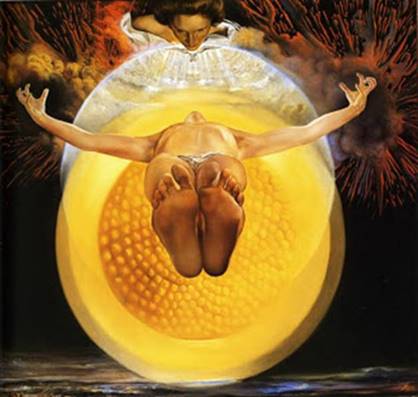Daily Reflection May 13 and 16, 2021 |
|
For those celebrating Thursday of the Sixth Week of Easter today |
My favorite depiction of the Ascension is Salvador Dali’s The Ascension: Pietá, 1958. This has been a fruitful image for visio divina for me, so I invite you to spend some time just looking at it and noticing what is there.
You might notice aspects of Christ’s body. He is positioned as though crucified, but he lacks any wounds. All of Dali’s crucifixion paintings show Jesus without wounds; they are all from the perspective of the Ascension, as well. Jesus’ lack of wounds in this painting doesn’t mean he is shown without suffering, though: his hands are contorted as though on the cross, with extreme pain. There are some red clouds or explosions near his hands, perhaps representing the evil he is fighting in the world. For Dali it might have been nuclear destruction, which appeared as a theme in many of his paintings. You might notice that Jesus’ feet are dirty. He has been walking around with us. His feet would have been the apostles’ last view of him as he was “lifted up and a cloud took him from their sight.” As Paul says to the Ephesians in one option for the second reading today, “What does ‘he ascended’ mean except that he also descended into the lower regions of the earth?” Christ scooped us up with him into heaven, even the dust of the earth from which God created humankind in Genesis. You might notice the woman at the top of the painting. This is the Blessed Virgin Mary, weeping at the suffering of the world. She is modeled on Dali’s wife. The first time I saw this painting, I thought the woman might be another representation of the Holy Spirit, like the dove at her chin, welcoming Christ in heaven even as she is going out to meet the world. Perhaps the most interesting symbols, though, are the interlocking spheres at the center of the painting. The white one, with the dove, is pretty obviously heaven. The gold one could be a representation of an atom, a nucleus, or a sun with a sunflower. The two circles overlap almost completely where Christ is. This speaks clearly of what today’s feast is all about: Christ has brought all of creation into heaven, from the cosmic down to the smallest particles. Christ divinized creation in the Ascension and we are already living as the Body of Christ. We have already been swept up into salvation. This, the divine Body of Christ, is what we experience in the Eucharist. You could also see the circles in the painting as the Blessed Sacrament, and the water at the bottom as the water of baptism. This very exciting truth – our membership in the Body of Christ – is the “hope that belongs to his call,” the unifying expression of “one body and one truth.” If we deeply realize this, as perhaps the apostles did in that moment as they watched Jesus, how can we keep from going “into the whole world to proclaim the Gospel to every creature?” As the angels said to the apostles, “Why are you standing there looking up at the sky?” Don’t you know who you are?! There is still much to be done, much suffering in the world, many people who desperately need good news. Get to work! “Go Out, Go Out” by Curtis Stephen |
Click on the link below to send an e-mail response |
Sharing this reflection with others by Email, on Facebook or Twitter:
See all the Resources we offer on our Online Ministries Home Page
